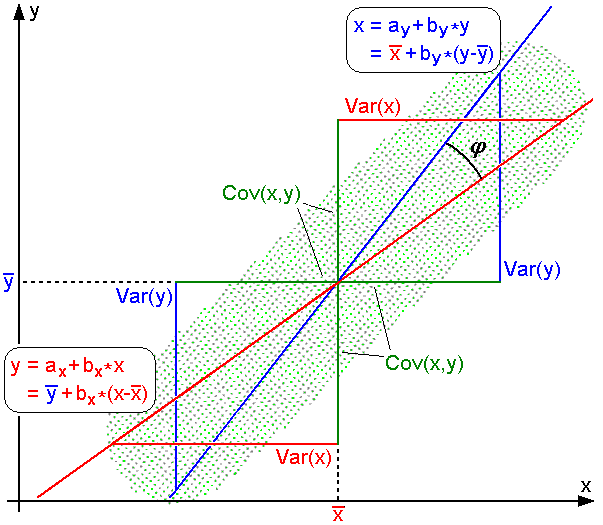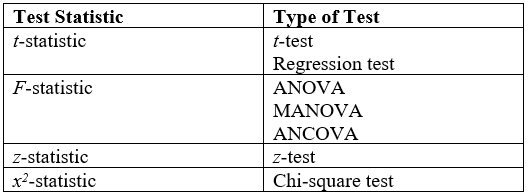|
Effect Size
In statistics, an effect size is a value measuring the strength of the relationship between two variables in a population, or a sample-based estimate of that quantity. It can refer to the value of a statistic calculated from a sample of data, the value of one parameter for a hypothetical population, or to the equation that operationalizes how statistics or parameters lead to the effect size value. Examples of effect sizes include the correlation between two variables, the regression coefficient in a regression, the mean difference, or the risk of a particular event (such as a heart attack) happening. Effect sizes are a complement tool for statistical hypothesis testing, and play an important role in power analyses to assess the sample size required for new experiments. Effect size are fundamental in meta-analyses which aim to provide the combined effect size based on data from multiple studies. The cluster of data-analysis methods concerning effect sizes is referred to as estima ... [...More Info...] [...Related Items...] OR: [Wikipedia] [Google] [Baidu] |
Statistics
Statistics (from German language, German: ', "description of a State (polity), state, a country") is the discipline that concerns the collection, organization, analysis, interpretation, and presentation of data. In applying statistics to a scientific, industrial, or social problem, it is conventional to begin with a statistical population or a statistical model to be studied. Populations can be diverse groups of people or objects such as "all people living in a country" or "every atom composing a crystal". Statistics deals with every aspect of data, including the planning of data collection in terms of the design of statistical survey, surveys and experimental design, experiments. When census data (comprising every member of the target population) cannot be collected, statisticians collect data by developing specific experiment designs and survey sample (statistics), samples. Representative sampling assures that inferences and conclusions can reasonably extend from the sample ... [...More Info...] [...Related Items...] OR: [Wikipedia] [Google] [Baidu] |
Absolute Value
In mathematics, the absolute value or modulus of a real number x, is the non-negative value without regard to its sign. Namely, , x, =x if x is a positive number, and , x, =-x if x is negative (in which case negating x makes -x positive), and For example, the absolute value of 3 and the absolute value of −3 is The absolute value of a number may be thought of as its distance from zero. Generalisations of the absolute value for real numbers occur in a wide variety of mathematical settings. For example, an absolute value is also defined for the complex numbers, the quaternions, ordered rings, fields and vector spaces. The absolute value is closely related to the notions of magnitude, distance, and norm in various mathematical and physical contexts. Terminology and notation In 1806, Jean-Robert Argand introduced the term ''module'', meaning ''unit of measure'' in French, specifically for the ''complex'' absolute value,Oxford English Dictionary, Draft Revision, Ju ... [...More Info...] [...Related Items...] OR: [Wikipedia] [Google] [Baidu] |
Pearson Product-moment Correlation Coefficient
In statistics, the Pearson correlation coefficient (PCC) is a correlation coefficient that measures linear correlation between two sets of data. It is the ratio between the covariance of two variables and the product of their standard deviations; thus, it is essentially a normalized measurement of the covariance, such that the result always has a value between −1 and 1. As with covariance itself, the measure can only reflect a linear correlation of variables, and ignores many other types of relationships or correlations. As a simple example, one would expect the age and height of a sample of children from a school to have a Pearson correlation coefficient significantly greater than 0, but less than 1 (as 1 would represent an unrealistically perfect correlation). Naming and history It was developed by Karl Pearson from a related idea introduced by Francis Galton in the 1880s, and for which the mathematical formula was derived and published by Auguste Bravais in 1844. The naming ... [...More Info...] [...Related Items...] OR: [Wikipedia] [Google] [Baidu] |
Explained Variation
In statistics, explained variation measures the proportion to which a mathematical model accounts for the variation ( dispersion) of a given data set. Often, variation is quantified as variance; then, the more specific term explained variance can be used. The complementary part of the total variation is called unexplained or residual variation; likewise, when discussing variance as such, this is referred to as unexplained or residual variance. Definition in terms of information gain Information gain by better modelling Following Kent (1983), we use the Fraser information (Fraser 1965) :F(\theta) = \int \textrmr\,g(r)\,\ln f(r;\theta) where g(r) is the probability density of a random variable R\,, and f(r;\theta)\, with \theta\in\Theta_i (i=0,1\,) are two families of parametric models. Model family 0 is the simpler one, with a restricted parameter space \Theta_0\subset\Theta_1. Parameters are determined by maximum likelihood estimation, :\theta_i = \operatorname_ F(\theta). ... [...More Info...] [...Related Items...] OR: [Wikipedia] [Google] [Baidu] |
Abelson's Paradox
Abelson's paradox is an applied statistics paradox identified by Robert P. Abelson. The paradox pertains to a possible paradoxical relationship between the magnitude of the ''r''2 (i.e., coefficient of determination) effect size and its practical meaning. Abelson's example was obtained from the analysis of the ''r''2 of batting average in baseball and skill level. Although batting average is considered among the most significant characteristics necessary for success, the effect size was only a tinyRoseman, I. J., & Read, S. J. (2007). "Psychologist at play: Abelson's life and contributions to psychological science." ''Perspectives on Psychological Science'', 2(1), p. 91. 0.003. See also * List of paradoxes This list includes well known paradoxes, grouped thematically. The grouping is approximate, as paradoxes may fit into more than one category. This list collects only scenarios that have been called a paradox by at least one source and have their ... References Sta ... [...More Info...] [...Related Items...] OR: [Wikipedia] [Google] [Baidu] |
P-value
In null-hypothesis significance testing, the ''p''-value is the probability of obtaining test results at least as extreme as the result actually observed, under the assumption that the null hypothesis is correct. A very small ''p''-value means that such an extreme observed outcome would be very unlikely ''under the null hypothesis''. Even though reporting ''p''-values of statistical tests is common practice in academic publications of many quantitative fields, misinterpretation and misuse of p-values is widespread and has been a major topic in mathematics and metascience. In 2016, the American Statistical Association (ASA) made a formal statement that "''p''-values do not measure the probability that the studied hypothesis is true, or the probability that the data were produced by random chance alone" and that "a ''p''-value, or statistical significance, does not measure the size of an effect or the importance of a result" or "evidence regarding a model or hypothesis". That ... [...More Info...] [...Related Items...] OR: [Wikipedia] [Google] [Baidu] |
Pearson Correlation
In statistics, the Pearson correlation coefficient (PCC) is a correlation coefficient that measures linear correlation between two sets of data. It is the ratio between the covariance of two variables and the product of their standard deviations; thus, it is essentially a normalized measurement of the covariance, such that the result always has a value between −1 and 1. As with covariance itself, the measure can only reflect a linear correlation of variables, and ignores many other types of relationships or correlations. As a simple example, one would expect the age and height of a sample of children from a school to have a Pearson correlation coefficient significantly greater than 0, but less than 1 (as 1 would represent an unrealistically perfect correlation). Naming and history It was developed by Karl Pearson from a related idea introduced by Francis Galton in the 1880s, and for which the mathematical formula was derived and published by Auguste Bravais in 1844. The namin ... [...More Info...] [...Related Items...] OR: [Wikipedia] [Google] [Baidu] |
Test Statistic
Test statistic is a quantity derived from the sample for statistical hypothesis testing.Berger, R. L.; Casella, G. (2001). ''Statistical Inference'', Duxbury Press, Second Edition (p.374) A hypothesis test is typically specified in terms of a test statistic, considered as a numerical summary of a data-set that reduces the data to one value that can be used to perform the hypothesis test. In general, a test statistic is selected or defined in such a way as to quantify, within observed data, behaviours that would distinguish the null from the alternative hypothesis, where such an alternative is prescribed, or that would characterize the null hypothesis if there is no explicitly stated alternative hypothesis. An important property of a test statistic is that its sampling distribution under the null hypothesis must be calculable, either exactly or approximately, which allows ''p''-values to be calculated. A ''test statistic'' shares some of the same qualities of a descriptive stat ... [...More Info...] [...Related Items...] OR: [Wikipedia] [Google] [Baidu] |
The Journal Of General Psychology
''The Journal of General Psychology'' is a quarterly peer-reviewed scientific journal covering experimental psychology. It was established in 1928 and is published by Routledge. The editors-in-chief are Paula Goolkasian ( University of North Carolina, Charlotte) and David Trafimow (New Mexico State University). According to the ''Journal Citation Reports'', the journal has a 2016 5-year impact factor The impact factor (IF) or journal impact factor (JIF) of an academic journal is a type of journal ranking. Journals with higher impact factor values are considered more prestigious or important within their field. The Impact Factor of a journa ... of 0.612. References External links *List of issues on Taylor & Francis Online Experimental psychology journals Quarterly journals Academic journals established in 1928 Routledge academic journals English-language journals {{Psychology-journal-stub ... [...More Info...] [...Related Items...] OR: [Wikipedia] [Google] [Baidu] |
Perceptual And Motor Skills
Perception () is the organization, identification, and interpretation of sense, sensory information in order to represent and understand the presented information or environment. All perception involves signals that go through the nervous system, which in turn result from physical or chemical stimulation of the Sensory nervous system, sensory system.Goldstein (2009) pp. 5–7 Visual system, Vision involves light striking the retina of the eye; Sense of smell, smell is mediated by Olfactory system#Peripheral, odor molecules; and hearing involves Sound wave, pressure waves. Perception is not only the passive receipt of these Signal processing, signals, but it is also shaped by the recipient's Perceptual learning, learning, memory, Expectation (epistemic), expectation, and attention.Richard Gregory, Gregory, Richard. "Perception" in Gregory, Zangwill (1987) pp. 598–601. Sensory input is a process that transforms this low-level information to higher-level information (e ... [...More Info...] [...Related Items...] OR: [Wikipedia] [Google] [Baidu] |
Publication Bias
In published academic research, publication bias occurs when the outcome of an experiment or research study biases the decision to publish or otherwise distribute it. Publishing only results that show a Statistical significance, significant finding disturbs the balance of findings in favor of positive results. The study of publication bias is an important topic in metascience. Despite similar quality of execution and Design of experiments, design, papers with statistically significant results are three times more likely to be published than those with null results. This unduly motivates researchers to manipulate their practices to ensure statistically significant results, such as by data dredging. Many factors contribute to publication bias. For instance, once a scientific finding is well established, it may become newsworthy to publish reliable papers that fail to reject the null hypothesis. Most commonly, investigators simply decline to submit results, leading to non-response ... [...More Info...] [...Related Items...] OR: [Wikipedia] [Google] [Baidu] |



